Advanced CQB: Footwork 1
Author: Instructor JB
Advanced Close Quarters Battle (CQB): Footwork 1 - Turn Right, Turn Left
Among the most fundamental close quarters battle (CQB) movements is moving through a doorway and turning to either the left or right to clear the corner. This article does not claim to describe the only way to clear a corner, but rather aims to offer a series of options, concepts and considerations to help each team or individual refine their techniques to a more advanced level.
Approaching the Door
Before you determine the best footwork to clear your corner, you must determine how you will approach the door. Several techniques are taught, but most fall into two categories:
1) Approaching the door head-on; and
2) Approaching the door at an angle.
Both have advantages and disadvantages, which we will now discuss.
1) Approaching the door head-on; and
2) Approaching the door at an angle.
Both have advantages and disadvantages, which we will now discuss.
Advantages and Disadvantages of Approaching the Door HEAD ON
Approaching the door head-on (as shown in image A below) provides improved visibility into the room as you approach. As you draw nearer to the door, the angle of your vision expands, exposing increasingly more of the room — you gain more time to identify, target, and neutralize adversaries.
Approaching head-on also makes it smoother and easier to turn either direction (left or right) when entering the room.
Finally, approaching the door head-on allows you to engage targets inside the room before crossing the threshold and exposing yourself to all threats inside the room. This technique typically involves approaching the door at an angle initially, then swinging out in an arc while scanning the room’s interior until you are facing the door. Depending on the situation, the arc can be wide or more shallow.
Approaching head-on also makes it smoother and easier to turn either direction (left or right) when entering the room.
Finally, approaching the door head-on allows you to engage targets inside the room before crossing the threshold and exposing yourself to all threats inside the room. This technique typically involves approaching the door at an angle initially, then swinging out in an arc while scanning the room’s interior until you are facing the door. Depending on the situation, the arc can be wide or more shallow.
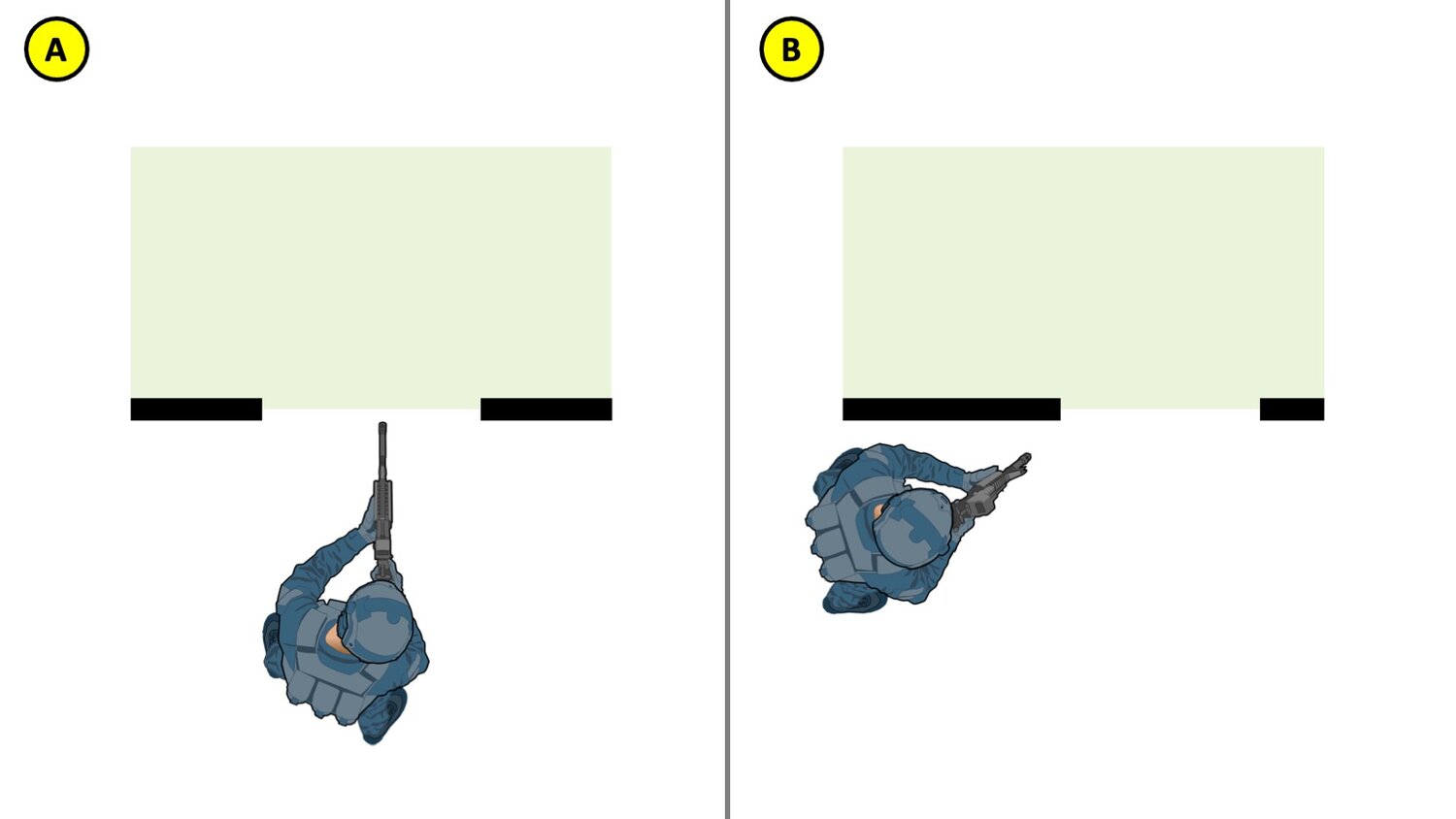
Approaching head-on (A) vs. approaching from an angle (B)
Approaching the door head-on does also have some potential disadvantages.
With better visibility into the room, you also expose yourself to threats within the room by standing in the notorious “fatal funnel.”
Also, focusing on the doorway may also make you more vulnerable to being shot by enemies to either side.
To avoid the fatal funnel as long as possible before entering the room, some may choose to approach the door at an angle (image B above). Although this reduces your initial exposure, you will have to react very quickly when you finally step through the doorway; and, your senses will have to take in the entire room in an instant, in contrast to the previous technique where you cleared much of the room from the outside.
Also, you must ensure your shadow does not extend across the doorway, thus revealing your presence and location. Most walls are not bulletproof and, if the adversary knows you are there, he may shoot you through the wall.
Finally, when approaching from a steep angle, many techniques suggest “breaking down” or lowering the weapon to avoid letting the muzzle pass in front of the door, giving away your position. This article focuses on footwork, but we will discuss the advantages and disadvantages of the various weapon handling techniques in a later article.
With better visibility into the room, you also expose yourself to threats within the room by standing in the notorious “fatal funnel.”
Also, focusing on the doorway may also make you more vulnerable to being shot by enemies to either side.
To avoid the fatal funnel as long as possible before entering the room, some may choose to approach the door at an angle (image B above). Although this reduces your initial exposure, you will have to react very quickly when you finally step through the doorway; and, your senses will have to take in the entire room in an instant, in contrast to the previous technique where you cleared much of the room from the outside.
Also, you must ensure your shadow does not extend across the doorway, thus revealing your presence and location. Most walls are not bulletproof and, if the adversary knows you are there, he may shoot you through the wall.
Finally, when approaching from a steep angle, many techniques suggest “breaking down” or lowering the weapon to avoid letting the muzzle pass in front of the door, giving away your position. This article focuses on footwork, but we will discuss the advantages and disadvantages of the various weapon handling techniques in a later article.
Head-on Approach: Exposing the Muzzle vs. Correct Pivot
When approaching the door head-on, the key point to remember when practicing your footwork is not to allow your weapon’s muzzle to extend into the room first, giving away your position. If it does, an adversary hiding in the corner will have additional time to react and shoot at you. See the illustration below.
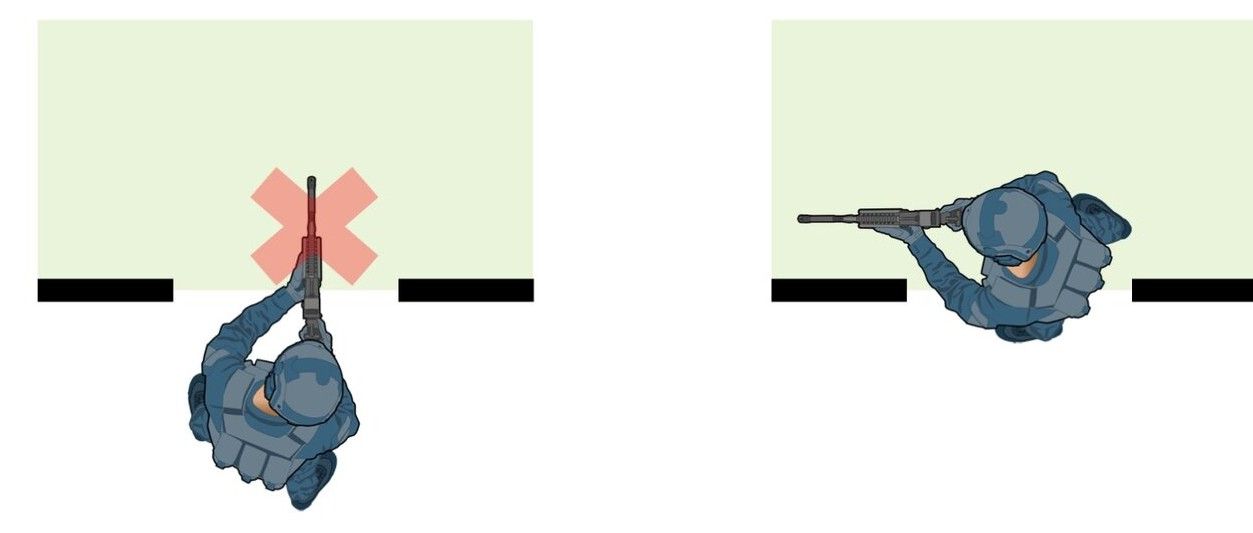
Don’t allow your muzzle to extend past the doorway before you clear the corner
The solution is to clear the immediate doorway area from outside the room, then pivot around the front of the weapon (the muzzle is the pivot point), so the first thing an adversary sees is your muzzle pointing at his face. With practice, you can do this quickly and smoothly — exposing as little of your body as possible in the process. See the illustration below.
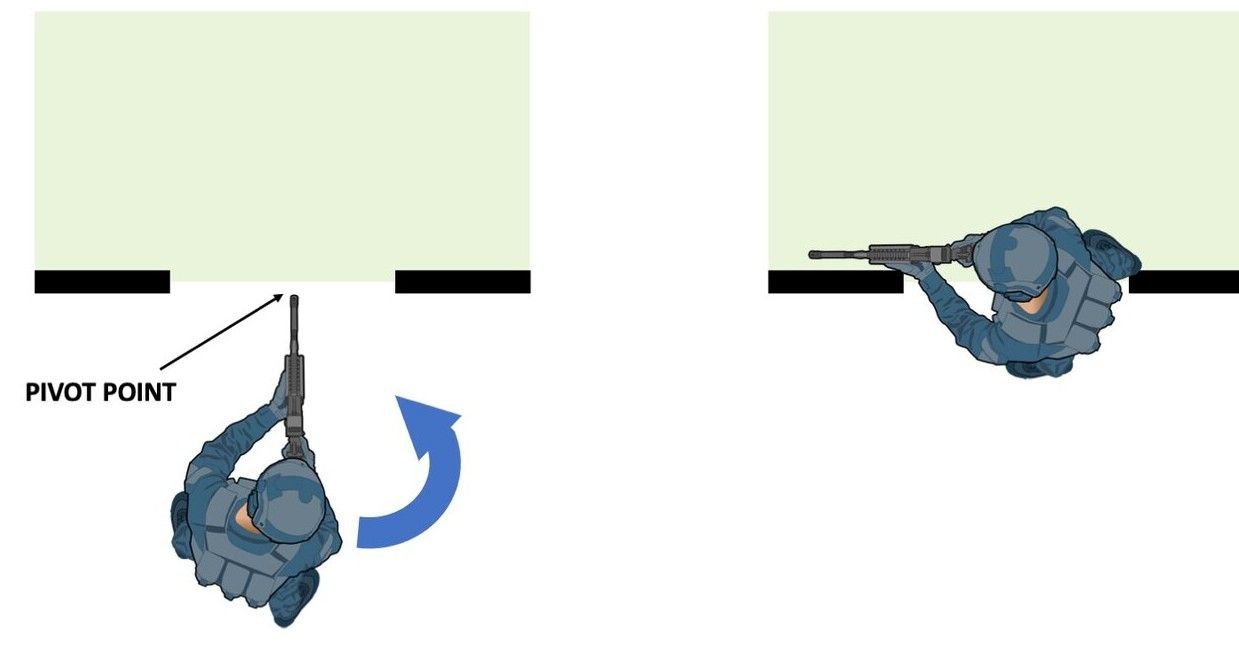
When approaching head-on, pivoting around the muzzle avoids exposing yourself to the corner.
Right Turn (or Strong-Side Turn)
Many tactical schools and trainers recommend that you refrain from deciding ahead of time whether to turn right or left when you enter the room. This retains maximum flexibility to adjust to unexpected threats or room configurations.
However, that also means your footwork patterns must also remain flexible. Also, when operating as part of a team, you do not know if you will be the first person into the room or if you will be following another team member. This will also affect your timing and footwork.
Therefore, establishing very rigid footwork patterns may cause you to get confused, stutter-step, or stumble when entering the room, which can be potentially disastrous.
Additionally, if you focus too much on your feet, you may find yourself looking at your feet, rather than focusing into the room looking for threats.
However, that also means your footwork patterns must also remain flexible. Also, when operating as part of a team, you do not know if you will be the first person into the room or if you will be following another team member. This will also affect your timing and footwork.
Therefore, establishing very rigid footwork patterns may cause you to get confused, stutter-step, or stumble when entering the room, which can be potentially disastrous.
Additionally, if you focus too much on your feet, you may find yourself looking at your feet, rather than focusing into the room looking for threats.
Therefore, one technique we recommend is illustrated in the images below, and executed as follows:
(1). Practice planting the weak-side foot (left foot for a right-handed shooter) two to three feet outside the door The exact position will vary depending on if you are approaching the door at an angle or head-on.
(2). If you choose to turn right, your next step will be slightly shorter as you start to pivot around your weapon toward the corner When approaching from an angle, this will be less of a pivot and more of a small outward step to set up your entry.
(3). Then, you can step through the door with your weak-side foot as you finish pivoting and your muzzle enters the room, pointed directly and immediately into the corner
(4). Finally, you can step in with your strong-side foot
(1). Practice planting the weak-side foot (left foot for a right-handed shooter) two to three feet outside the door The exact position will vary depending on if you are approaching the door at an angle or head-on.
(2). If you choose to turn right, your next step will be slightly shorter as you start to pivot around your weapon toward the corner When approaching from an angle, this will be less of a pivot and more of a small outward step to set up your entry.
(3). Then, you can step through the door with your weak-side foot as you finish pivoting and your muzzle enters the room, pointed directly and immediately into the corner
(4). Finally, you can step in with your strong-side foot
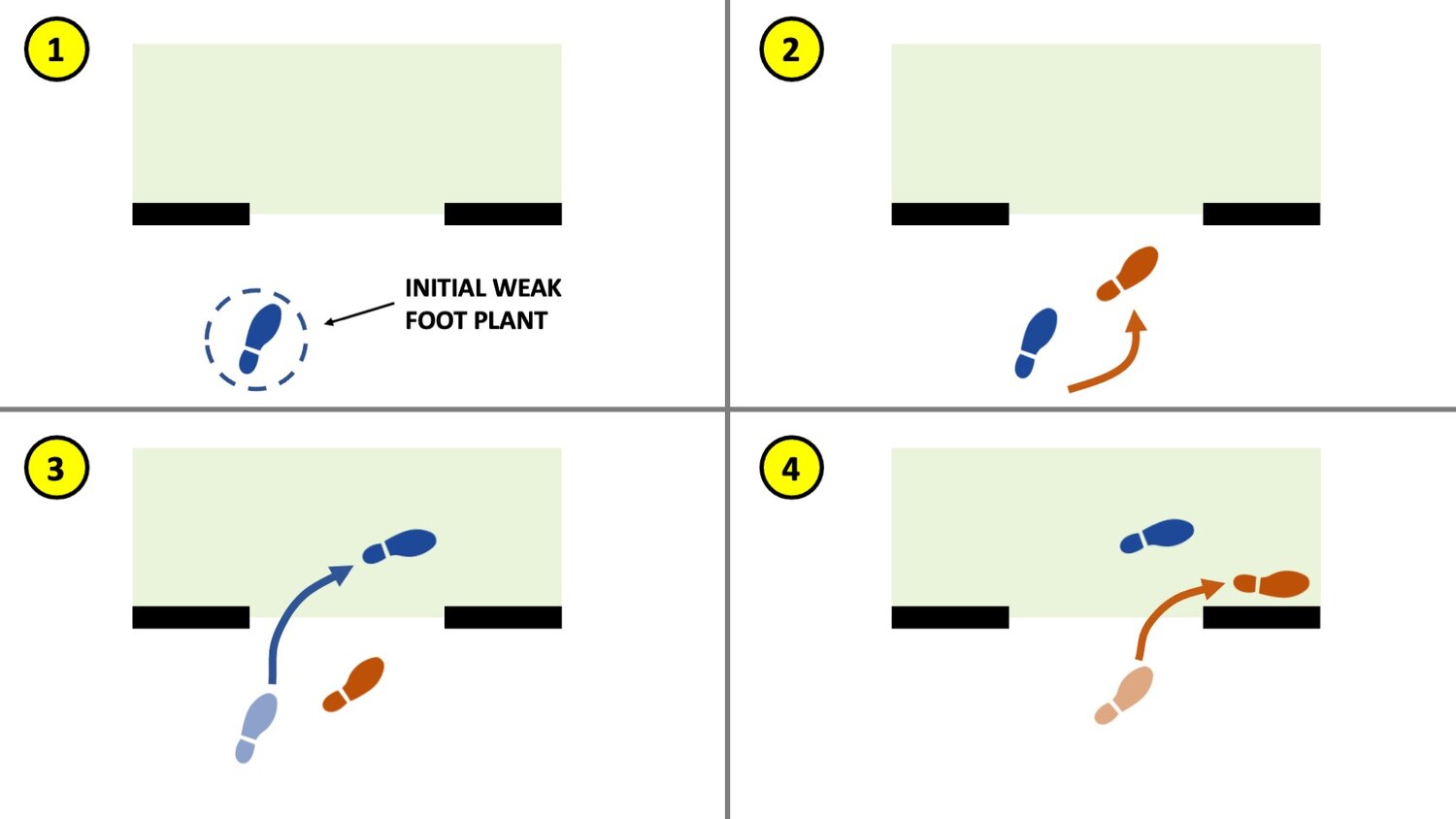
Example of footwork for a right turn (or strong-side turn)
Left Turn (or Weak-Side Turn)
Should you choose to turn left, that process is illustrated in the images below, and executed as follows:
(1). You still plant the weak-side foot (left foot for a right-handed shooter) about two to three feet outside the door. Note that since the initial foot placement is the same, it gives you the flexibility to rapidly decide to turn right or left based on immediate threats.
(2). Should you choose to turn left, your next step will be longer, placing your strong-side foot near the door jam on the same side while pivoting your body to the left around your weapon. Widening your step to the right will increase space for the weapon if you are carrying a rifle; and once again, the first thing an adversary hiding in the corner should see should be your muzzle.
(3). As you finish pivoting toward the corner, your weak-side foot can step forward into the room near the wall.
(4). Finally, your strong-side foot can follow.
(1). You still plant the weak-side foot (left foot for a right-handed shooter) about two to three feet outside the door. Note that since the initial foot placement is the same, it gives you the flexibility to rapidly decide to turn right or left based on immediate threats.
(2). Should you choose to turn left, your next step will be longer, placing your strong-side foot near the door jam on the same side while pivoting your body to the left around your weapon. Widening your step to the right will increase space for the weapon if you are carrying a rifle; and once again, the first thing an adversary hiding in the corner should see should be your muzzle.
(3). As you finish pivoting toward the corner, your weak-side foot can step forward into the room near the wall.
(4). Finally, your strong-side foot can follow.
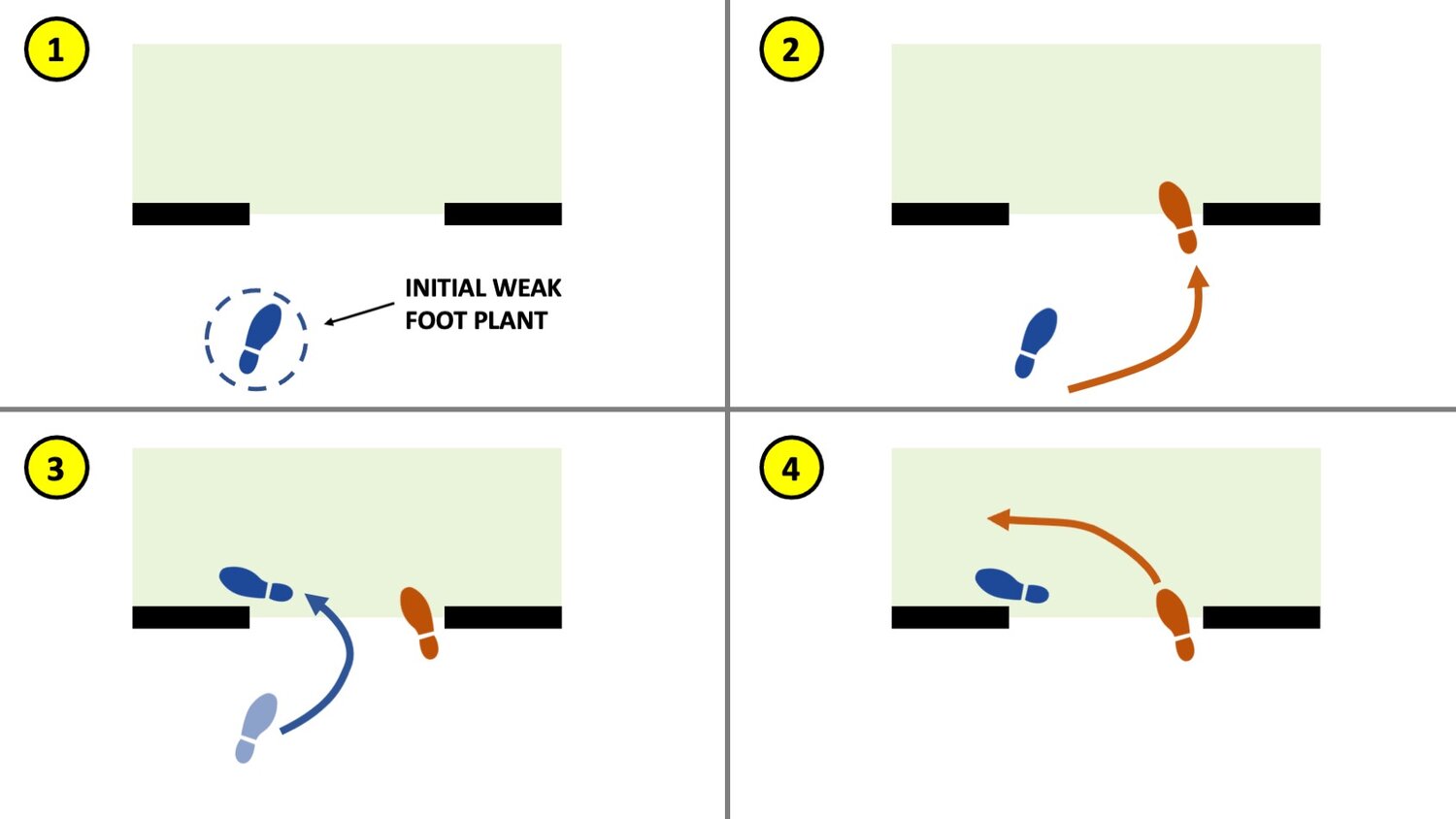
Example of footwork for a left turn (or weak-side turn)
Putting the Technique Together
These are not presented as ironclad rules but rather guidelines and concepts for you to experiment with.
These fundamental principles of footwork can apply to various entry techniques whether you are approaching head-on, at a steep angle, or somewhere in between, and using either a rifle or a pistol.
The most critical point is to practice these techniques and experiment with them to learn how to adjust them to fit your body mechanics and personal preferences.
Follow on articles in this series will discuss other aspects and components of advanced close quarters battle (CQB).
These fundamental principles of footwork can apply to various entry techniques whether you are approaching head-on, at a steep angle, or somewhere in between, and using either a rifle or a pistol.
The most critical point is to practice these techniques and experiment with them to learn how to adjust them to fit your body mechanics and personal preferences.
Follow on articles in this series will discuss other aspects and components of advanced close quarters battle (CQB).
©Copyright Special Tactics, LLC. Published with permission.
Iron Survival, LLC
Featured links
Policy Pages
©Copyright 2026 Iron Survival, LLC
